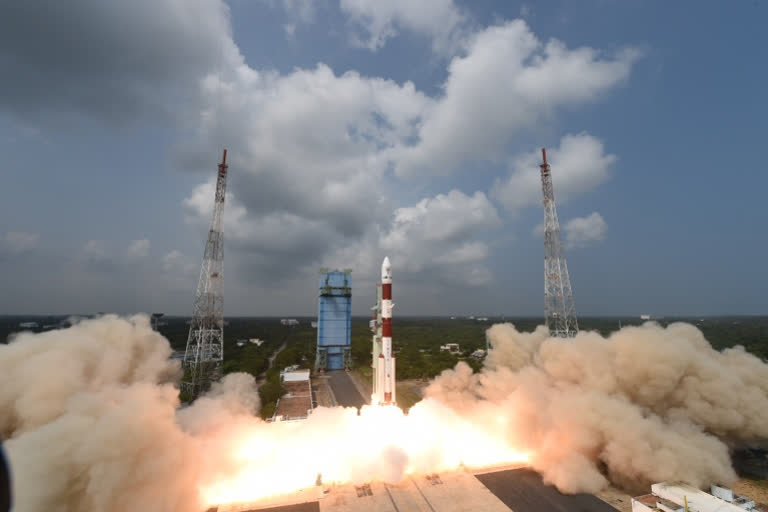Chennai: The PSLV-C54 rocket which was launched from Sriharikota on Saturday has successfully placed the Oceansat and eight co-passenger satellites into intended orbits, the Indian Space Research Organisation (ISRO) said. The 56th flight of the Polar Satellite Launch Vehicle (PSLV), in its extended version (PSLV-XL), lifted-off at 11.56 AM on Saturday (November 26th) from the first launchpad at the Satish Dhawan Space Centre, Sriharikota, a source said.
The primary payload of the rocket is an Oceansat which separated in orbit-1 while the eight other nano-satellites have been placed in different orbits based on the customer requirements (in the Sun-synchronous polar orbits). Including the primary payload, nine satellites are piggy-backing on the 44.4-metre high PSLV-C54 which has a lift-off mass of 321 tonne. It is also the 24th flight of the PSLV-XL version.
The mission is one of the longest ones undertaken by the ISRO scientists who engaged the rocket to change orbits using two-orbit change thrusters (OCTs) used in the PSLV-C54 launch vehicle. The separation of the Earth Observation Satellite took place in orbit-1 while the passenger payloads were separated in Orbit-2.
The Earth Observation Satellite was placed at an altitude of about 742 km about 20 minutes after lift-off. After the primary satellite separation, the vehicle was lowered to reach an altitude of 516 km for placing of the first passenger satellite. The last payload separation took place at an altitude of about 528 km, ISRO said. After reaching the intended orbit 17 minutes after PSLV-C54 lifted off, the Earth Observation Satellite or the 'Oceansat' successfully separated from the rocket and was placed into orbit.
In a tweet, ISRO said, "PASLV-C54/EOS-06 Mission: EOS-06 spacecraft separation is successful. The spacecraft's health is normal. The mission is continuing." Scientists would perform lowering of the rocket to place the other co-passenger satellites into a different orbit which is expected to take place in a two-hour duration.
Also read: ISRO conducts 200th consecutive successful launch of RH200 sounding rocket
In his address at the Mission Control Centre, ISRO Chairman S Somanath said, "I am really happy to announce the successful accomplishment of injecting the EOS-06 (Earth Observation satellite) into the intended orbit very precisely." "We also observed that the performance of the rocket in this mission in all stages and functions was exceedingly good. And congratulations to the entire team of PSLV for making yet another successful mission in the series of its long journey," he said. "Scientists had actually planned to launch the Earth Observation Satellite at 1,032 seconds after lift-off at 11.56 am. The rocket successfully placed the satellite at 1,033 seconds at an altitude of about 742 kms", he added.
"The mission is not completed and we are waiting for the change of orbit of the upper stage along with the remaining eight satellites," said Mission Director S R Biju. "The EOS-6 satellite has been injected into precise orbit as precisely as possible, it is because of the excellent team effort put in by all the team members and that is 'Team ISRO'. Team ISRO always delivers and that is again proven here," he said.
The Earth Observation Satellite-6 is the third-generation satellite in the Oceansat series. This is to provide continuity services of Oceansat-2 spacecraft with enhanced payload specifications as well as application areas. The objective of the mission is to ensure data continuity of ocean colour and wind vector data to sustain the operational applications.
The customer payloads include ISRO Nano Satellite-2 for Bhutan (INS-2B) which would have two payloads namely NanoMx and APRS-Digipeater. NanoMx is a multispectral optical imaging payload developed by Space Applications Centre while APRS-Digipeater payload is jointly developed by Department of Information Technology and Telecom, Bhutan, and U R Rao Satellite Centre, Bengaluru.
The 'Anand' satellite developed by Pixxel is technology demonstrator to demonstrate the capabilities and commercial applications of miniature earth observation camera for observation using a micro-satellite in low earth orbit. The 'Thybolt' (two satellites) is from another space start-up Dhruva Space while Astrocast is a technology demonstrator satellite for the internet of things as the payload from Spaceflight, the United States of America.




